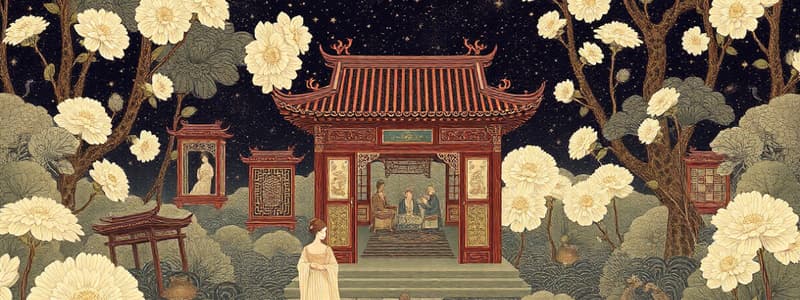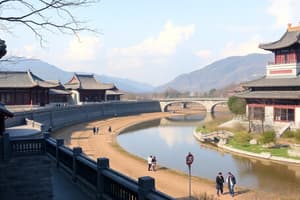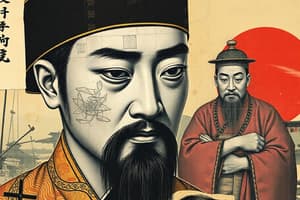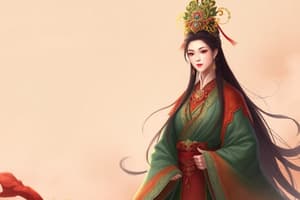Podcast
Questions and Answers
How did the construction of the Grand Canal impact China during the Sui Dynasty?
How did the construction of the Grand Canal impact China during the Sui Dynasty?
- It led to the decline of agriculture in northern China due to increased reliance on southern rice imports.
- It facilitated the transportation of troops to suppress rebellions in southern China.
- It allowed for the efficient transportation of rice from the south to the north, affecting the cuisine and economy. (correct)
- It primarily served as a defensive barrier against invasions from the north, similar to the Great Wall.
Which characteristic did the Sui Dynasty share with the Qin Dynasty?
Which characteristic did the Sui Dynasty share with the Qin Dynasty?
- The implementation of a decentralized feudal system with regional lords holding significant power.
- A long and stable reign marked by peace and economic prosperity.
- A focus on maritime exploration and trade with other empires.
- Extensive public works projects, such as the Great Wall and Grand Canal, at a high human cost. (correct)
What led to the downfall of the Sui Dynasty?
What led to the downfall of the Sui Dynasty?
- Internal conflict between different factions within the ruling family vying for power.
- Successful invasions by nomadic tribes from the north, leading to widespread chaos.
- A series of devastating earthquakes that destroyed key infrastructure.
- Exhaustion and revolt of the army due to costly construction projects and expansions. (correct)
Which dynasty followed the Sui Dynasty, ushering in a golden age and emulating aspects of the Han Dynasty?
Which dynasty followed the Sui Dynasty, ushering in a golden age and emulating aspects of the Han Dynasty?
What was significant about Chang'an under the Tang Dynasty?
What was significant about Chang'an under the Tang Dynasty?
The invention of movable type printing during the Tang Dynasty primarily facilitated:
The invention of movable type printing during the Tang Dynasty primarily facilitated:
Tea cultivation during the Tang Dynasty marked a significant cultural and economic shift in China because it:
Tea cultivation during the Tang Dynasty marked a significant cultural and economic shift in China because it:
Wu Zetian's reign as empress during the Tang Dynasty is most notably characterized by her:
Wu Zetian's reign as empress during the Tang Dynasty is most notably characterized by her:
The Song Dynasty's introduction of paper money and letters of credit primarily indicates:
The Song Dynasty's introduction of paper money and letters of credit primarily indicates:
The flourishing of arts and poetry during the Song Dynasty was significantly fueled by:
The flourishing of arts and poetry during the Song Dynasty was significantly fueled by:
Flashcards
Movable type printing
Movable type printing
Printing system using movable components to reproduce the elements of a document.
Tea in Tang Dynasty
Tea in Tang Dynasty
Important crop and drink of choice, popularized during Tang Dynasty.
Wu Zetian
Wu Zetian
China's only woman ruler, who declared herself emperor.
Song Dynasty
Song Dynasty
Signup and view all the flashcards
Paper Money & Letters of Credit
Paper Money & Letters of Credit
Signup and view all the flashcards
Southern and Northern Dynasties
Southern and Northern Dynasties
Signup and view all the flashcards
Sui Dynasty
Sui Dynasty
Signup and view all the flashcards
Grand Canal
Grand Canal
Signup and view all the flashcards
Chang'an
Chang'an
Signup and view all the flashcards
Study Notes
Three Dynasties Overview
- Followed the Han Dynasty's breakup in the 3rd century AD.
- The Jin Dynasty briefly restored rule but fell into the Southern and Northern Dynasties period.
- In 589, the Sui Dynasty emerged, uniting China.
- The Sui Dynasty was the first of three dynasties during a Golden Age of Chinese culture.
- Created lasting innovations in China.
Sui Dynasty (589 AD)
- United China in 589, addressing disunity issues.
- Often compared to the Qin Dynasty.
- Renovated the Great Wall of China.
- Expanded China, incorporating Xinjiang and Vietnam.
- Built the Grand Canal that facilitated rice shipments from southern to northern China, impacting cuisine.
- Faced issues similar to the Qin, including high costs in lives for construction projects like the Great Wall renovation (over one million deaths).
- Conquests in Vietnam and Xinjiang weakened the army, resulting in a revolt in 618 AD.
Tang Dynasty (618 - 907 AD)
- Founded by a leader of the revolt against the Sui.
- China reached a high point similar to the Han period.
- Emulated the Han Dynasty.
- Made Chang'an the capital, which became a major global city with over 1.5 million residents.
- Saw innovation, including the invention of moveable type printing.
- Tea became an important crop and popular beverage.
- Wu Zetian, a former concubine, declared herself empress and emperor, establishing her own Zhou Dynasty.
- Wu Zetian challenged Confucian ideals on women's subservience and promoted Buddhism.
- Confucian bureaucracy resisted her efforts, leading to her removal and the Tang restoration.
Song Dynasty (960 - 1271 AD)
- Established in 960, after a period of dynastic rise and fall following the Tang.
- Ruled until the Mongol conquest in 1271.
- The Song Dynasty signified a high point of Chinese culture.
- Paper money and letters of credit were introduced.
- The bureaucracy grew more complex, and administrators followed paths based on skill.
- Administrators were restricted from returning home to prevent favoritism.
- The Imperial Administration improved crop yields through breeding and research.
- Merchants gained power and wealth, and supported artists and poets.
- Celebrated poets captured themes such as nature, love, service, and indulgence.
Studying That Suits You
Use AI to generate personalized quizzes and flashcards to suit your learning preferences.




